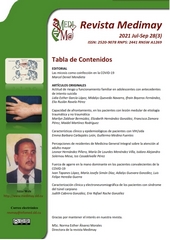Fuerza de agarre en la mano dominante en los pacientes convalecientes de la COVID-19
Keywords:
adulto mayor, sexo, fuerza de agarre, coronavirus, COVID-19Abstract
Introducción:
La pandemia del nuevo coronavirus, SARS-CoV-2, está considerada como el mayor desafío sanitario ocurrido en el mundo, investigadores describen algunos aspectos a tener en consideración, sobre el efecto que tiene la COVID-19, en las personas mayores.
Objetivo:
Evaluar la fuerza de agarre en la mano dominante en pacientes convalecientes de la COVID-19.
Métodos:
Se realizó un estudio descriptivo y de corte transversal, en 35 pacientes pertenecientes a un centro de protección social, que tuvieron la COVID-19, en el periodo comprendido entre y junio del 2020. Las variables en estudio fueron: edad, sexo, evaluación nutricional, fuerza de agarre en mano dominante. Para el procesamiento de los resultados se utilizaron medidas de resumen para variables cualitativas (números absolutos y porcentajes) y para variables cuantitativas (media y desviación standard).
Resultados:
La edad media de la población estudiada fue de 63.0 años, predomina el sexo masculino y los pacientes de 60 años y más, con un porcentaje de 97.1 %, con respecto al femenino que fue de 2.9 %. Predominó la mano derecha como dominante, donde la fuerza de agarre fue de 21.7±7.3 Kg y con relación al sexo, los hombres tuvieron mayor fuerza que las féminas 22.1±7.2Kg; el valor de la fuerza muscular, en la mano dominante fue de 21.3±7.4 kg.
Conclusiones:
Existe un estado de dinapenia, en los pacientes, después de haber enfermado por la COVID- 19.
Downloads
References
Jin H, Hong C, Chen S, Zhou Y, Wang Y, Mao L, et al. Consensus for prevention and management of coronavirus disease 2019 (COVID-19) for neurologists. Stroke Vasc Neurol[Internet]. 2020 Jun[citado 23 Jul 2021]; 5(2): 146–51. Disponible en: https://www.ncbi.nlm.nih.gov/pmc/articles/PMC7211095/pdf/svn-2020-000382.pdf
Lloyd-Sherlock P, Ebrahim S, Leon Geffen L, McKee M. Bearing the brunt of covid-19: older people in low- and middle-income countries. BMJ. 2020; 368 doi: https://doi.org/10.1136/bmj.m1052
Moug S, Carter B, Kyaw Myint P, Hewitt J, McCarthy K, Pearce L. Decision-Making in COVID-19 and Frailty. Geriatrics (Basel) [Internet].2020 May [citado 23 Jun 2021];5(2):30. Disponible en: https://www.mdpi.com/2308-3417/5/2/30
Petretto DP, Pili R. Ageing and COVID-19: What is the Role for Elderly People. Geriatrics[Internet]. 2020[citado 23 Jul 2021];5(2):25.Disponible en: https://www.ncbi.nlm.nih.gov/pmc/articles/PMC7345165/pdf/geriatrics-05-00025.pdf
Cesari M, Proietti M. Geriatric medicine in Italy in the time of COVID-19. J Nutr Health Aging[Internet]. 2020 Abr[citado 23 Jul 2021];24:1–2. Disponible en: https://www.ncbi.nlm.nih.gov/pmc/articles/PMC7118363/pdf/12603_2020_Article_1354.pdf
Kingston A, Robinson L, Booth H, Knapp M, Jagger C. Projections of multi-morbidity in the older population in England to 2035: estimates from the population ageing and care simulation (PACSim) model. Age Ageing [Internet]. 2018 May [citado 23 Jul 2021];47(3):374-80.Disponible en: https://www.ncbi.nlm.nih.gov/pmc/articles/PMC5920286/pdf/afx201.pdf
Deng S. Q, Peng H. J. Characteristics of and public health responses to the coronavirus disease 2019 outbreak in China. Journal of Clinical Medicine. 2020; 9(2). https://doi.org/10.3390/jcm9020575
Elisabeth M. Coronavirus covid-19 has killed more people than SARS and MERS combined, despite lower case fatality rate. BMJ[Internet]. 2020[citado 23 Jul 2021];368:m641. Disponible en: https://www.bmj.com/content/bmj/368/bmj.m641.full.pdf
Wei-jie Guan PD, Zheng-yi N, Yu Hu MD, Wen-hua L, Chun-quan OU. Clinical Characteristics of Coronavirus Disease 2019 in China. N Engl J Med[Internet]. 2020[citado 23 Jul 2021];382:1708-20. Disponible en: https://www.nejm.org/doi/full/10.1056/nejmoa2002032
Gemelli Against COVID-19 Geriatrics Team. The geriatrician: the frontline specialist in the treatmentof COVID-19 PATIENTS. Journal American Medical Directors Association [Internet].2020 Jul [citado 23 Jul 2021].21(7):937-8.Disponible en: https://www.ncbi.nlm.nih.gov/pmc/articles/PMC7177102/pdf/main.pdf
Hernández Martínez J, Cisterna D, Ramírez Campillo R, Álvarez C, Guede Rojas F, Fuente C et al. Association of maximal voluntary isometric handgrip strength with age, gender and handedness in older people. Rev Méd Chile [Internet]. 2018 Dic [citado 30 Jul 2020];146(12):1429437.Disponible en: https://scielo.conicyt.cl/scielo.php?script=sci_arttext&pid=S0034872018001201429&lng=es
Hernández-Martínez JG, Anguita-Vera C, Asenjo-Flores P, Solis-Millaguin M, Asenjo-Paredes C. Niveles de fuerza de agarre de mano y composición corporal de mujeres mayores chilenas. E F Deportes[Internet]. 2019 Sep[citado 30 Jul 2020];24(256):46-8. Disponible en: https://www.efdeportes.com/efdeportes/index.php/EFDeportes/article/view/951 .
Hernández Martínez J, Ramírez Campillo R. Predicción de Sarcopenia mediante la Fuerza de Agarre de Mano en Adultos Mayores. Rev Horiz Ciencactfís[Internet]. 2017[citado 30 Jul 2020];(8)1:27-36. Disponible en: http://revistahorizonte.ulagos.cl/index.php/horizonte/article/view/7/4
Goncalves D. Functional capacity and obesity reflect the cognitive performance of older adults living in long-term care facilities. Psychogeriatrics[Internet]. 2017 Nov[citado 23 Jul 2021];17(6):439-45.Disponible en: https://onlinelibrary.wiley.com/doi/epdf/10.1111/psyg.12273
Tapia PC, Valdivia-Rojas Y, Varela VH, Carmona GA, Iturra MV, Jorquera CM. Indicadores de fragilidad en adultos mayores del sistema público de salud de la ciudad de Antofagasta. Rev Méd Chile [Internet]. 2015 Abr[citado 23 Jul 2021];143(4): 459-66. Disponible en: http://www.scielo.cl/scielo.php?script=sci_arttext&pid=S0034-98872015000400007&lng=es.
Bohannon RW, Magasi S. Identification of dynapeniain older adults through the use of grip strength t-scores. Muscle Nerve[Internet]. 2015[citado 30 jul 2020]; 51 (1):
-5.Disponible en: https://www.ncbi.nlm.nih.gov/pmc/articles/PMC4194263/pdf/nihms585574.pdf
Wang L, Crawford J D, Reppermund S, Trollor J, Campbell L, Baune B T et al. Body mass index and waist circumference predict health-related quality of life, but not satisfaction with life, in the elderly. Qual Life Res[Internet]. 2018[citado 30 Jul 2020]; 27(10):2653-65. Disponible en: https://link.springer.com/article/10.1007/s11136-018-1904-6
Hernández-Martínez J, Coronado-Toledo J, Cisterna-García D, Solis Millaguin M, Téllez-Saldivia D. Puede la Obesidad alterar la potencia y fuerza muscular de mujeres Adultas Mayores. Rev Horiz Ciencactfís[Internet]. 2019[citado 30 Jul 2020];(10)2:1-9.Disponible en: http://revistahorizonte.ulagos.cl/index.php/horizonte/article/view/157/147
Carvalho D, Scholes S, Santos J, de Oliveira C y Alexandre T. Does Abdominal Obesity Accelerate Muscle Strength Decline in Older Adults? J Gerontol A Biol Sci Med Sci[Internet]. 2019 Jun[citado 30 Jul 2020]; 74(7):1105-11.Disponible en: https://www.ncbi.nlm.nih.gov/pmc/articles/PMC6580692/pdf/gly178.pdf
Koster A, Ding J, Stenholm S, Caserotti P, Houston D, Nicklas B, et al. Does the amount of fat mass predict age-related loss of lean mass, muscle strength, and muscle quality in older adults? J Gerontol A Biol Sci Med Sci[Internet]. 2011[citado 30 Jul 2020];66(8):888-95. Disponible en: https://www.ncbi.nlm.nih.gov/pmc/articles/PMC3184893/pdf/glr070.pdf
Downloads
Published
How to Cite
Issue
Section
License
Medimay protects copyright from the very first moment the submission is made, but upon publication it assumes a Creative Commons 4.0 (cc-by-nc) license, which allows the use of the work to share (copy and redistribute the material in any medium or format) and adapt (remix, transform and build from the material) as long as exclusive mention is made of the publication in the journal as a primary source, prohibiting its commercialization. The author always retains his/her right.















 This site is licensed under a
This site is licensed under a